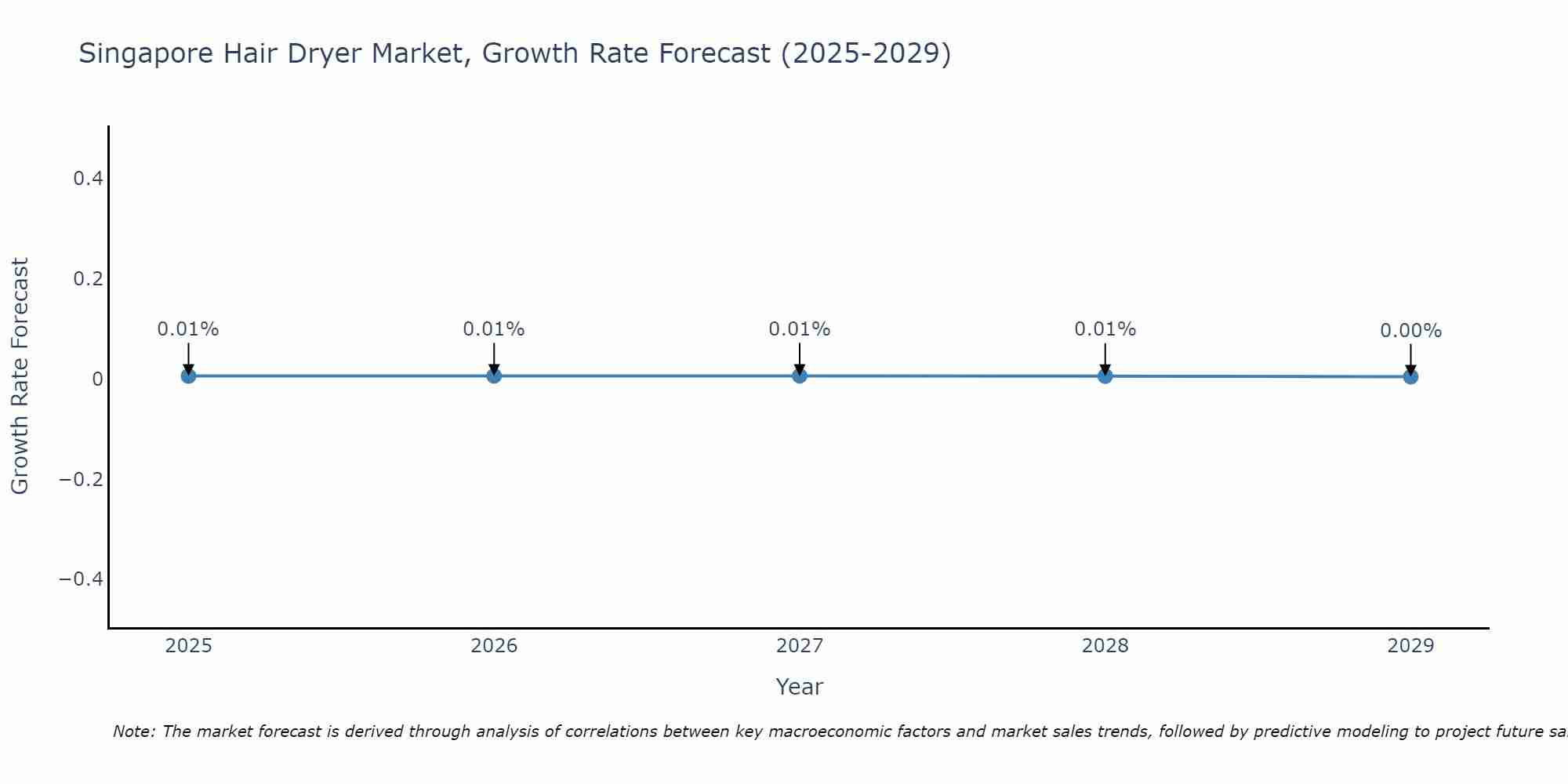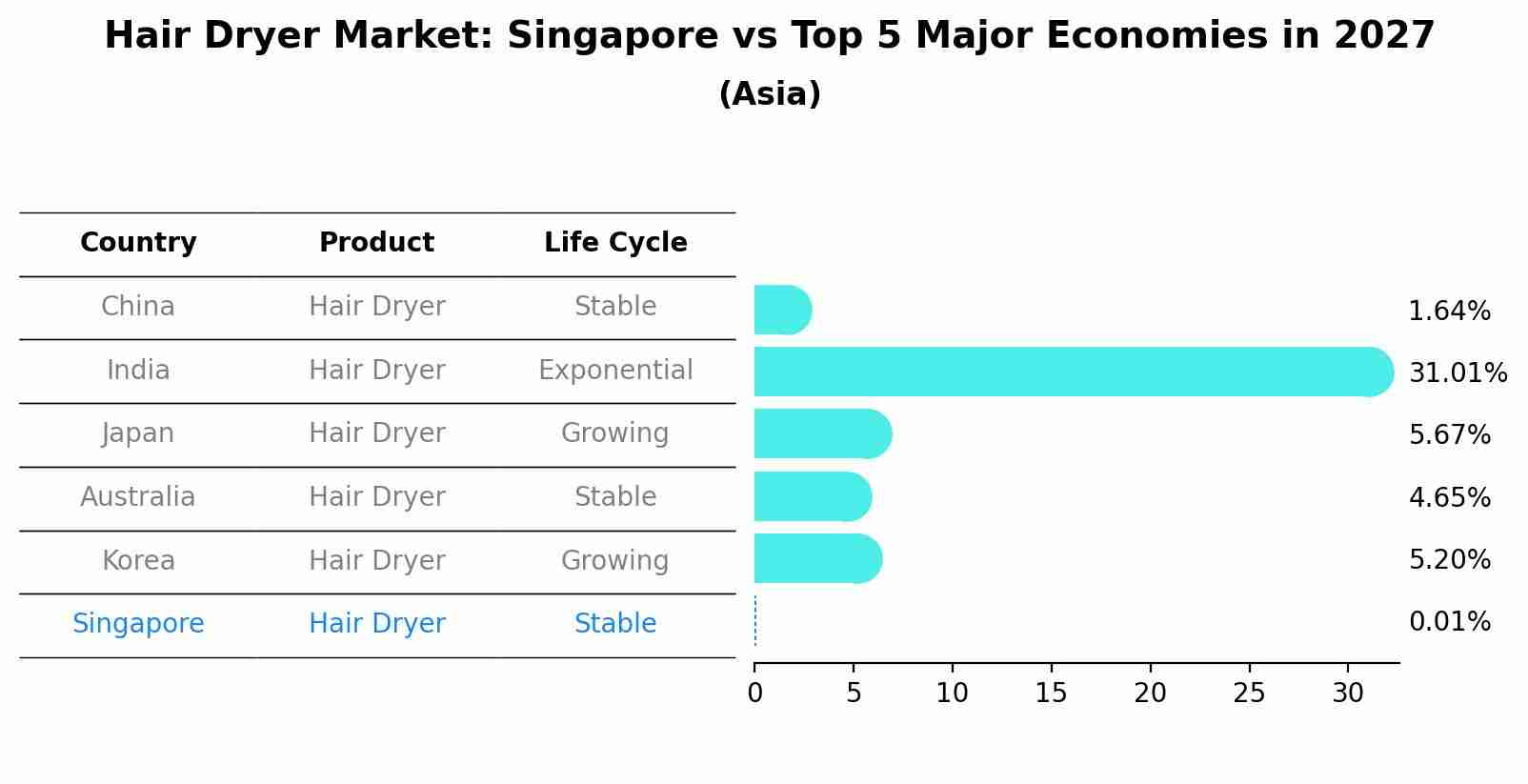Singapore Hair Dryer Market (2025-2031) Outlook | Share, Revenue, Growth, Industry, Size, Value, Analysis, Companies, Forecast & Trends
| Product Code: ETC084106 | Publication Date: Jun 2021 | Updated Date: Apr 2025 | Product Type: Report | |
| Publisher: 6Wresearch | No. of Pages: 70 | No. of Figures: 35 | No. of Tables: 5 | |
Singapore Hair Dryer Market Size Growth Rate
The Singapore Hair Dryer Market is projected to witness mixed growth rate patterns during 2025 to 2029. Growth accelerates to 0.01% in 2027, following an initial rate of 0.01%, before easing to 0.00% at the end of the period.

Hair Dryer Market: Singapore vs Top 5 Major Economies in 2027 (Asia)
By 2027, Singapore's Hair Dryer market is forecasted to achieve a stable growth rate of 0.01%, with China leading the Asia region, followed by India, Japan, Australia and South Korea.

Singapore Hair Dryer Market Synopsis
The hair dryer market in Singapore is thriving as personal grooming and styling become increasingly important in people`s lives. Hair dryers are a staple in households and salons, and technological advancements have led to the availability of feature-rich and efficient models. Singapore beauty and personal care industry is well-established, and consumers are willing to invest in high-quality grooming appliances. The market is characterized by a wide range of products, from affordable options to premium, salon-grade hair dryers. As the demand for hair care and styling products remains steady, the hair dryer market in Singapore is poised for continued growth.
Drivers of the Market
The hair dryer market in Singapore is poised for growth, driven by factors such as increasing personal grooming and styling trends. With a growing population and rising disposable incomes, consumers are investing in grooming and personal care products, including hair dryers. Additionally, the tourism sector in Singapore attracts visitors who may need such products during their stay. The market is also influenced by technological advancements, with features like ionic technology and faster drying times becoming more popular among consumers. As a result, the hair dryer market in Singapore is likely to see steady growth.
Challenges of the Market
The hair dryer market in Singapore faces stiff competition from both local and international brands. One major challenge is keeping up with rapidly changing technology and consumer preferences. Energy efficiency and noise reduction are becoming more important, and hair dryer manufacturers need to invest in research and development to stay competitive. Moreover, the market is affected by fluctuations in disposable income, which can impact consumer spending on non-essential grooming products.
COVID-19 Impact on the Market
The Singapore hair dryer market, like many consumer electronics segments, experienced a temporary setback during the early stages of the COVID-19 pandemic. With lockdowns and reduced consumer spending, the demand for hair dryers declined. However, as people adjusted to remote work and video conferencing, there was a subsequent surge in grooming and self-care products, including hair dryers. Brands that adapted to online sales channels and offered innovative features like faster drying times or reduced noise levels fared better.
Key Players in the Market
The Singapore hair dryer market continues to experience steady growth due to increased personal grooming awareness and demand for advanced hair care products. Key players in this market include Panasonic, Philips, Dyson, BaByliss, and Remington, which offer a range of innovative and high-quality hair dryers to cater to consumer needs.
Key Highlights of the Report:
- Singapore Hair Dryer Market Outlook
- Market Size of Singapore Hair Dryer Market, 2024
- Forecast of Singapore Hair Dryer Market, 2031
- Historical Data and Forecast of Singapore Hair Dryer Revenues & Volume for the Period 2021-2031
- Singapore Hair Dryer Market Trend Evolution
- Singapore Hair Dryer Market Drivers and Challenges
- Singapore Hair Dryer Price Trends
- Singapore Hair Dryer Porter's Five Forces
- Singapore Hair Dryer Industry Life Cycle
- Historical Data and Forecast of Singapore Hair Dryer Market Revenues & Volume By Product for the Period 2021-2031
- Historical Data and Forecast of Singapore Hair Dryer Market Revenues & Volume By Corded for the Period 2021-2031
- Historical Data and Forecast of Singapore Hair Dryer Market Revenues & Volume By Cordless for the Period 2021-2031
- Historical Data and Forecast of Singapore Hair Dryer Market Revenues & Volume By Application for the Period 2021-2031
- Historical Data and Forecast of Singapore Hair Dryer Market Revenues & Volume By Professional for the Period 2021-2031
- Historical Data and Forecast of Singapore Hair Dryer Market Revenues & Volume By Individual for the Period 2021-2031
- Historical Data and Forecast of Singapore Hair Dryer Market Revenues & Volume By Distribution Channel for the Period 2021-2031
- Historical Data and Forecast of Singapore Hair Dryer Market Revenues & Volume By Offline for the Period 2021-2031
- Historical Data and Forecast of Singapore Hair Dryer Market Revenues & Volume By Online for the Period 2021-2031
- Singapore Hair Dryer Import Export Trade Statistics
- Market Opportunity Assessment By Product
- Market Opportunity Assessment By Application
- Market Opportunity Assessment By Distribution Channel
- Singapore Hair Dryer Top Companies Market Share
- Singapore Hair Dryer Competitive Benchmarking By Technical and Operational Parameters
- Singapore Hair Dryer Company Profiles
- Singapore Hair Dryer Key Strategic Recommendations
Frequently Asked Questions About the Market Study (FAQs):
1 Executive Summary |
2 Introduction |
2.1 Key Highlights of the Report |
2.2 Report Description |
2.3 Market Scope & Segmentation |
2.4 Research Methodology |
2.5 Assumptions |
3 Singapore Hair Dryer Market Overview |
3.1 Singapore Country Macro Economic Indicators |
3.2 Singapore Hair Dryer Market Revenues & Volume, 2021 & 2031F |
3.3 Singapore Hair Dryer Market - Industry Life Cycle |
3.4 Singapore Hair Dryer Market - Porter's Five Forces |
3.5 Singapore Hair Dryer Market Revenues & Volume Share, By Product, 2021 & 2031F |
3.6 Singapore Hair Dryer Market Revenues & Volume Share, By Application, 2021 & 2031F |
3.7 Singapore Hair Dryer Market Revenues & Volume Share, By Distribution Channel, 2021 & 2031F |
4 Singapore Hair Dryer Market Dynamics |
4.1 Impact Analysis |
4.2 Market Drivers |
4.3 Market Restraints |
5 Singapore Hair Dryer Market Trends |
6 Singapore Hair Dryer Market, By Types |
6.1 Singapore Hair Dryer Market, By Product |
6.1.1 Overview and Analysis |
6.1.2 Singapore Hair Dryer Market Revenues & Volume, By Product, 2021-2031F |
6.1.3 Singapore Hair Dryer Market Revenues & Volume, By Corded, 2021-2031F |
6.1.4 Singapore Hair Dryer Market Revenues & Volume, By Cordless, 2021-2031F |
6.2 Singapore Hair Dryer Market, By Application |
6.2.1 Overview and Analysis |
6.2.2 Singapore Hair Dryer Market Revenues & Volume, By Professional, 2021-2031F |
6.2.3 Singapore Hair Dryer Market Revenues & Volume, By Individual, 2021-2031F |
6.3 Singapore Hair Dryer Market, By Distribution Channel |
6.3.1 Overview and Analysis |
6.3.2 Singapore Hair Dryer Market Revenues & Volume, By Offline, 2021-2031F |
6.3.3 Singapore Hair Dryer Market Revenues & Volume, By Online, 2021-2031F |
7 Singapore Hair Dryer Market Import-Export Trade Statistics |
7.1 Singapore Hair Dryer Market Export to Major Countries |
7.2 Singapore Hair Dryer Market Imports from Major Countries |
8 Singapore Hair Dryer Market Key Performance Indicators |
9 Singapore Hair Dryer Market - Opportunity Assessment |
9.1 Singapore Hair Dryer Market Opportunity Assessment, By Product, 2021 & 2031F |
9.2 Singapore Hair Dryer Market Opportunity Assessment, By Application, 2021 & 2031F |
9.3 Singapore Hair Dryer Market Opportunity Assessment, By Distribution Channel, 2021 & 2031F |
10 Singapore Hair Dryer Market - Competitive Landscape |
10.1 Singapore Hair Dryer Market Revenue Share, By Companies, 2024 |
10.2 Singapore Hair Dryer Market Competitive Benchmarking, By Operating and Technical Parameters |
11 Company Profiles |
12 Recommendations |
13 Disclaimer |
- Single User License$ 1,995
- Department License$ 2,400
- Site License$ 3,120
- Global License$ 3,795
Search
Related Reports
- Saudi Arabia Manlift Market (2025-2031) | Outlook, Size, Growth, Trends, Companies, Industry, Revenue, Value, Share, Forecast & Analysis
- Uganda Excavator, Crane, and Wheel Loaders Market (2025-2031) | Strategy, Consumer Insights, Analysis, Investment Trends, Opportunities, Growth, Size, Share, Industry, Revenue, Segments, Value, Segmentation, Supply, Forecast, Restraints, Outlook, Competition, Drivers, Trends, Demand, Pricing Analysis, Competitive, Strategic Insights, Companies, Challenges
- Rwanda Excavator, Crane, and Wheel Loaders Market (2025-2031) | Strategy, Consumer Insights, Analysis, Investment Trends, Opportunities, Growth, Size, Share, Industry, Revenue, Segments, Value, Segmentation, Supply, Forecast, Restraints, Outlook, Competition, Drivers, Trends, Demand, Pricing Analysis, Competitive, Strategic Insights, Companies, Challenges
- Kenya Excavator, Crane, and Wheel Loaders Market (2025-2031) | Strategy, Consumer Insights, Analysis, Investment Trends, Opportunities, Growth, Size, Share, Industry, Revenue, Segments, Value, Segmentation, Supply, Forecast, Restraints, Outlook, Competition, Drivers, Trends, Demand, Pricing Analysis, Competitive, Strategic Insights, Companies, Challenges
- Angola Excavator, Crane, and Wheel Loaders Market (2025-2031) | Strategy, Consumer Insights, Analysis, Investment Trends, Opportunities, Growth, Size, Share, Industry, Revenue, Segments, Value, Segmentation, Supply, Forecast, Restraints, Outlook, Competition, Drivers, Trends, Demand, Pricing Analysis, Competitive, Strategic Insights, Companies, Challenges
- Israel Intelligent Transport System Market (2025-2031) | Strategy, Consumer Insights, Analysis, Investment Trends, Opportunities, Growth, Size, Share, Industry, Revenue, Segments, Value, Segmentation, Supply, Forecast, Restraints, Outlook, Competition, Drivers, Trends, Demand, Pricing Analysis, Competitive, Strategic Insights, Companies, Challenges
- Uganda Precast and Aggregate Market (2025-2031) | Strategy, Consumer Insights, Analysis, Investment Trends, Opportunities, Growth, Size, Share, Industry, Revenue, Segments, Value, Segmentation, Supply, Forecast, Restraints, Outlook, Competition, Drivers, Trends, Demand, Pricing Analysis, Competitive, Strategic Insights, Companies, Challenges
- Australia IT Asset Disposal Market (2025-2031) | Strategy, Consumer Insights, Analysis, Investment Trends, Opportunities, Growth, Size, Share, Industry, Revenue, Segments, Value, Segmentation, Supply, Forecast, Restraints, Outlook, Competition, Drivers, Trends, Demand, Pricing Analysis, Competitive, Strategic Insights, Companies, Challenges
- UAE Building Thermal Insulation Market Outlook (2025-2031) | Revenue, Companies, Share, Trends, Growth, Size, Forecast, Industry, Analysis & Value
- Portugal Electronic Document Management Market (2025-2031) | Strategy, Consumer Insights, Analysis, Investment Trends, Opportunities, Growth, Size, Share, Industry, Revenue, Segments, Value, Segmentation, Supply, Forecast, Restraints, Outlook, Competition, Drivers, Trends, Demand, Pricing Analysis, Competitive, Strategic Insights, Companies, Challenges
Industry Events and Analyst Meet
Our Clients
Whitepaper
- Middle East & Africa Commercial Security Market Click here to view more.
- Middle East & Africa Fire Safety Systems & Equipment Market Click here to view more.
- GCC Drone Market Click here to view more.
- Middle East Lighting Fixture Market Click here to view more.
- GCC Physical & Perimeter Security Market Click here to view more.
6WResearch In News
- Doha a strategic location for EV manufacturing hub: IPA Qatar
- Demand for luxury TVs surging in the GCC, says Samsung
- Empowering Growth: The Thriving Journey of Bangladesh’s Cable Industry
- Demand for luxury TVs surging in the GCC, says Samsung
- Video call with a traditional healer? Once unthinkable, it’s now common in South Africa
- Intelligent Buildings To Smooth GCC’s Path To Net Zero













